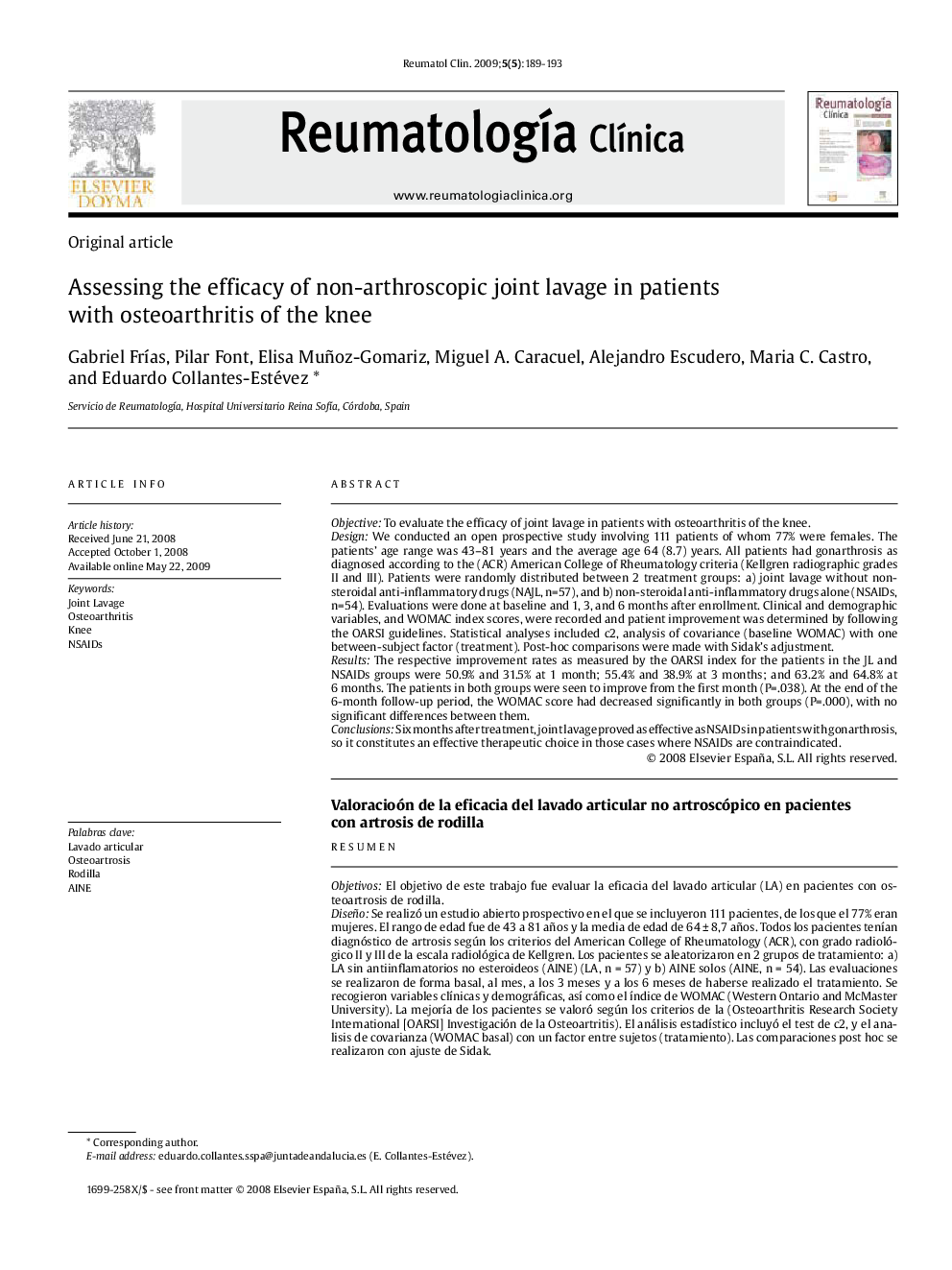| Article ID | Journal | Published Year | Pages | File Type |
|---|---|---|---|---|
| 3384702 | Reumatología Clínica (English Edition) | 2009 | 5 Pages |
ObjectiveTo evaluate the efficacy of joint lavage in patients with osteoarthritis of the knee.DesignWe conducted an open prospective study involving 111 patients of whom 77% were females. The patients’ age range was 43–81 years and the average age 64 (8.7) years. All patients had gonarthrosis as diagnosed according to the (ACR) American College of Rheumatology criteria (Kellgren radiographic grades II and III). Patients were randomly distributed between 2 treatment groups: a) joint lavage without nonsteroidal anti-inflammatory drugs (NAJL, n = 57), and b) non-steroidal anti-inflammatory drugs alone (NSAIDs, n = 54). Evaluations were done at baseline and 1, 3, and 6 months after enrollment. Clinical and demographic variables, and WOMAC index scores, were recorded and patient improvement was determined by following the OARSI guidelines. Statistical analyses included c2, analysis of covariance (baseline WOMAC) with one between-subject factor (treatment). Post-hoc comparisons were made with Sidak's adjustment.ResultsThe respective improvement rates as measured by the OARSI index for the patients in the JL and NSAIDs groups were 50.9% and 31.5% at 1 month; 55.4% and 38.9% at 3 months; and 63.2% and 64.8% at 6 months. The patients in both groups were seen to improve from the first month (P=.038). At the end of the 6-month follow-up period, the WOMAC score had decreased significantly in both groups (P = .000), with no significant differences between them.ConclusionsSix months after treatment, joint lavage proved as effective as NSAIDs in patients with gonarthrosis, so it constitutes an effective therapeutic choice in those cases where NSAIDs are contraindicated.
ResumenObjetivosEl objetivo de este trabajo fue evaluar la eficacia del lavado articular (LA) en pacientes con osteoartrosis de rodilla.DiseñoSe realizó un estudio abierto prospectivo en el que se incluyeron 111 pacientes, de los que el 77% eran mujeres. El rango de edad fue de 43 a 81 años y la media de edad de 64 ± 8,7 años. Todos los pacientes tenían diagnóstico de artrosis según los criterios del American College of Rheumatology (ACR), con grado radiológico II y III de la escala radiológica de Kellgren. Los pacientes se aleatorizaron en 2 grupos de tratamiento: a) LA sin antiinflamatorios no esteroideos (AINE) (LA, n = 57) y b) AINE solos (AINE, n = 54). Las evaluaciones se realizaron de forma basal, al mes, a los 3 meses y a los 6 meses de haberse realizado el tratamiento. Se recogieron variables clínicas y demográficas, así como el índice de WOMAC (Western Ontario and McMaster University). La mejoría de los pacientes se valoró según los criterios de la (Osteoarthritis Research Society International [OARSI] Investigación de la Osteoartritis). El análisis estadístico incluyó el test de c2, y el analisis de covarianza (WOMAC basal) con un factor entre sujetos (tratamiento). Las comparaciones post hoc se realizaron con ajuste de Sidak.ResultadosEl grado de mejoría según los criterios de la OARSI para los pacientes del grupo LA y del grupo AINE fue, respectivamente: 50,9 y 31,5% al mes; 55,4 y 38,9% a los 3 meses, y 63,2 y 64,8% a los 6 meses. Los pacientes en ambos grupos mejoraron desde el primer mes (p = 0,038). Al final de los 6 meses del seguimiento, el WOMAC había descendido significativamente en ambos grupos (p = 0,000), sin que hubiera diferencias significativas entre ellos.ConclusionesA los 6 meses del tratamiento, el LA es tan eficaz como los AINE en pacientes con gonartrosis, por lo que es una alternativa terapeútica eficaz en los pacientes en los que los AINE están contraindicados.
